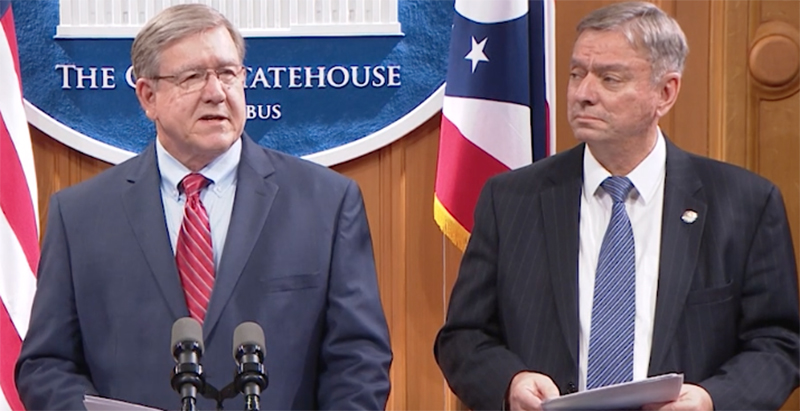COVID-19 Budget Woes Pose Challenge for Ohio’s Long-Awaited School Funding Overhaul

Ohio legislators hope to end a two-decade fight over the constitutionality of school funding this fall with a much-anticipated new formula for state aid that would give schools an estimated $2 billion more annually when fully implemented.
But the recession caused by the COVID-19 pandemic is adding an extra challenge to an already-difficult fix, raising the possibility that Ohio may not have enough money to pay for it.
The proposed “Fair Funding Formula,” a bipartisan plan developed over three years, has wide support from legislators and cautious optimism from school districts and teachers across the state.
It might finally end Ohio’s over-reliance on local property taxes to pay for schools, which the Supreme Court has said makes the system inequitable. It changes how Ohio would handle funding for poor districts, for growing districts and for charter schools and private school tuition vouchers. It also creates a structure for determining what it costs to give a student a proper education.
By giving schools an average of $1,100 more per student, the plan would also cost the state nearly $2 billion more a year if fully implemented. That’s on top of the nearly $11 billion the state spends on schools now.
Coming up with any extra money next year, even just to start phasing the plan in over multiple years, looks like a tough task right now. Unemployment and business declines from the pandemic already forced the state to cut $300 million from schools earlier this year and the state is bracing for a budget shortfall again next year.
“We’re staring at a $2 billion funding gap come next budget cycle and this has a $2 billion price tag on it,” said State Rep. Jay Edwards, the Republican Majority Whip. “If we’re going to do this, I want to make sure it’s right, not something that we’re just throwing money at.”
State Sen. Peggy Lehner, chair of the Senate Education Committee, also knows that COVID-19, which has surged to record levels across Ohiot makes it uncertain how much of the plan the state can afford.
“There’s no question the pandemic is going to make it a more difficult task for all of us,” said Lehner, who introduced the plan as a bill in the Senate last week. “It’s going to affect everything in the budget next year. And who knows how long it weighs beyond the financial impact. How long are we going to stay semi-locked down?”
But Lehner said she hopes the legislature can pass the formula this fall and it can be paid for over time.
“We’re going to plow ahead and do the best we can,” she said.
School funding in Ohio has been controversial, as it is in just about any state, for decades, with major battles over how much the state should pay and local taxes should pay. The Ohio Supreme Court ruled three separate times in the late 1990s and early 2000s that the state violates the state constitution by putting too much burden for school costs on local property taxes.
Since then, the state funding system has been adjusted multiple times by different governors, but never to a point that there is any consensus that it has been fixed. Voters across Ohio complain every time a school tax hike is proposed that the state funding is still unconstitutional.
Ohio’s funding problem isn’t that low-income schools have much less money for students than high-income schools, as they do in some other states. Both low and high-income schools are spending about the same amount of local and state tax dollars, a 2018 study for Ohio’s schools boards and school officials showed.
But equal funding isn’t equitable, many argue, since high poverty districts have more special education students and English Language Learners, along with more poverty challenges to overcome.
Three years ago, State Reps. Robert Cupp, a Republican and John Patterson, a Democrat, began working together on a new plan and formed committees of school officials from across the state to work on it. The plan was considered as part of the state’s two-year budget in 2019, but was sent back for more work.
Now that Cupp has become House Speaker, its chances of passing have increased.
Its biggest changes include:
- Increasing the average state aid from about $4,500 to about $5,600 per student.
- That varies by district though. Cleveland will receive about $9,400 per student and the high-povertyEast Cleveland school district will receive about $16,000, while aid to affluent areas may only be a few hundred per student.
- Using different weights for family income and local property values to determine what residents of a school district can afford to pay for schools with their local taxes and adjusting state aid accordingly.
- Creating a framework for determining how much money schools need to educate a child. That includes separate calculations for costs of teachers, supplies, technology, transportation and administration.Ohio has not had any such estimates in decades.
- Having the state pay directly for charter schools and private school tuition vouchers. Previously, the state would deduct charter and voucher costs from each students’ home school district. Those deductions angered districts, particularly when they exceeded the per-pupil state aid the district receives.
- Adding more money to cover district costs for poverty, disabilities and English Language Learners, though additional studies must still be done to set final amounts.
The latest version of the plan, unveiled last week, would give poor urban districts increases while also giving large ones to growing suburban districts whose state aid has been capped the last few years because the state didn’t have enough money.
The Cleveland school district would receive an 11% increase in state aid under this formula, Akron 25 percent, Cincinnati 52 percent, Columbus 101 percent and Toledo 17 percent. Cleveland’s and Toledo’s increases are lower because they are not growing.
The Cleveland school district said in an email that it supports the plan’s attempt to base funding on actual costs to educate students and that it adds money for student needs. But the district declined further comment until it can study the updated plan more.
The plan also calls for a six-year phase-in, which supporters hope can work despite the COVID-19 recession.
How much damage the recession will cause to the state budget is still to be determined, particularly as the state continues setting records for COVID-19 cases. Before the recent surge, Ohio’s unemployment rate had fallen to 8 percent in September, down from more than 17 percent in April. The state also reported last month that several economic indexes showed the state recovering from spring pandemic business shutdowns.
But state officials are warning that the state could still be $2 billion short of projections next year and may have to dip into its $2.7 billion rainy day fund to avoid massive cuts, House Majority Floor Leader Bill Seitz, a Cincinnati Republican, said at a public forum last week. Any federal aid to schools could also help.
“We’re going to have to find revenue somewhere,” said Seitz.
Get stories like these delivered straight to your inbox. Sign up for The 74 Newsletter

;)

